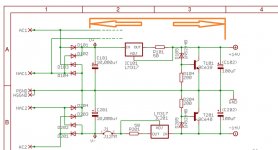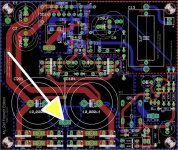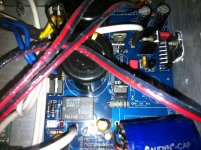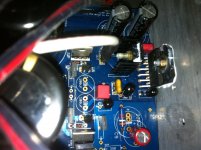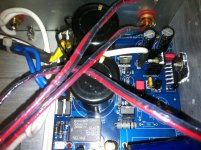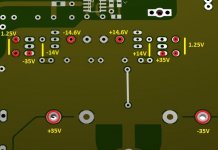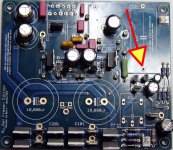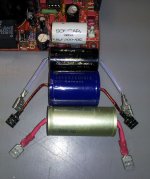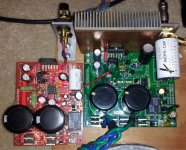I will remove the diodes and see what happens.What voltage reading should I be getting across there?
I don't know, I measure voltage mainly on PS lines.
I would first fix the PS rails (+-14V).
I would use that for checking relative voltages.
But I find device Vdrops to be far more useful in trying understand a circuit and trying to debug a broken circuit. I am useless at debugging.
I found the same when running my racing cars. Because they almost always ran perfectly well, I never got a chance to develop debugging skills. People would see how well my cars ran, they would come to me with their problems, but I didn't have a clue on how they begin to debug. Ask a Garage trained Technician who looks at broken cars/circuits all day and every day. That is his forte. He does not get requests "check why my car never breaks down" !!!
But I find device Vdrops to be far more useful in trying understand a circuit and trying to debug a broken circuit. I am useless at debugging.
I found the same when running my racing cars. Because they almost always ran perfectly well, I never got a chance to develop debugging skills. People would see how well my cars ran, they would come to me with their problems, but I didn't have a clue on how they begin to debug. Ask a Garage trained Technician who looks at broken cars/circuits all day and every day. That is his forte. He does not get requests "check why my car never breaks down" !!!
Thanks, I'm sure Dario will give some direction here.
P.S. In my minds eye I'm having trouble seeing you in or around a race car. Just demonstrates how faulty our perceptive abilities can be - particularly with just online communications. The big question - were you any good.
Just demonstrates how faulty our perceptive abilities can be - particularly with just online communications. The big question - were you any good. 
P.S. In my minds eye I'm having trouble seeing you in or around a race car.
Badri, Unfortunately it appears you will have to take the same path as Marra. The voltages are the clearest method to solving problems. The schematic is linked a few posts back, and if you have difficulties knowing where to place the probes - please post and someone will help.
Thanks Bob. I didnt do any measurement so far. I will be doing it little later because of work. But today I have checked it again. Audio coming from one channel without any hum. And I measured the DC of this. It is showing in -ve (-6). Is it normal? Or am I doing wrong? And in another board both R3 resistor and LM3886 getting too hot. Not able to touch it. The DC is 55mV. Any inputs Bob? Forgot to mention, a muffled, distorted audio is coming from the faulty board but its breaking for each second.
Thanks
Badri
Attachments
Last edited:
It's my understanding that ~12 - 15 mv and lower is acceptable - lower is better. I noticed you replaced R3 previously so my guess would be a problem before that resistor. I hate to ask, but some pictures of the underside are needed. It's a pain to remove the module from the heat sink but those pictures are really needed to confirm a correct build.
It's my understanding that ~12 - 15 mv and lower is acceptable - lower is better. I noticed you replaced R3 previously so my guess would be a problem before that resistor. I hate to ask, but some pictures of the underside are needed. It's a pain to remove the module from the heat sink but those pictures are really needed to confirm a correct build.
Thanks Bob. I didnt replace R3 before. But I changed R11 because it got opened. Pictures of the back side of the board will be posting later because of work.
Thanks
Badri
Dario, can you identify any practical measurement points between the two red arrows in this pic?
Interesting measuring points:
Real world voltages are around 34.5V for the 35V.
Having a measure different from 1.25V on current setting resistors could indicate a faulty LM317
Thanks, I'm sure Dario will give some direction here.
My troubleshooting abilities are not advanced but so far big parts of problems comes from:
- wrong value components used
- bad solder joints
- static damage
The first part to test is the PS.
If it measures well go ahead to the amp, otherwise check parts values, solder joints and replace active components (rectifiers if 35V fail, LM317 and BC639/BC640, zeners if 14V fails).
If PS measured voltages are good check amp section's parts value, solder joints and replace LM318 and LM3886 (remove first D1, D2, D3, when the amp works replace them).
It's a bit rough approach and. maybe costly but it worked for me several times.
And I measured the DC of this. It is showing in -ve (-6). Is it normal? Or am I doing wrong?
I can't understand can you clarify?
Is it the working board?
With -ve are you refererring to the supposed -14V?
And in another board both R3 resistor and LM3886 getting too hot. Not able to touch it. The DC is 55mV. Any inputs Bob? Forgot to mention, a muffled, distorted audio is coming from the faulty board but its breaking for each second.
Measure the PS first, if it works correctly relace LM318 and LM3886 after measuring all passives.
Attachments
Last edited:
My apologies to Jac for dilly dallying, but I finally had a chance to hear the K71 caps. I'm not sure how much they cost (Jac implied very inexpensive) but they compete strongly with everything I have tested. As I see it, there are two costs ranges that apply: $10 and under - Sonicap, Audyn Plus and K71 (I think) & $20 or more - Mundorf ZN and Audyn True Copper.
I still like the Audyn offerings with my system. Both present an airiness and separation that presents what I label as a "Refined" sound. I need to lean in that direction because I listen to a lot of complex Big Band and Classical music. I admit the other caps generally provide a bit more color, impact and/or warmth. I actually preferred the richer, dynamic presentation when I started building these amps a few years ago. Now I lean toward "the best improvised jazz solos come from musicians who know what to leave out" approach to amps.
The K71 sounds very full and musical. I tried them in both rotations and they followed what appears to be a pattern: one direction emphasizes volume and presence, the other produces a lighter more dispersed sound. In the first instance I preferred what the K71s did for the low end. The floor vibrating pedals were just as strong as the TCs but better controlled - almost like being able to perceive the cycles within very low sounds. I don't think I have heard anything better.
One of my test tracks starts with a high pitched orchestral bell that, through its duration, seems to find resonance in every corner of the room. The K71s produced it as well as anything I have tested. That is followed by some acoustic guitar with lots of fret noise. Again the K71 caught all the detail with clarity and brightness.
Where they fell down was on the vocal. Though very rich and a little forward, the edges were fuzzy and somewhat pronounced - leading to a touch of muddiness - when compared to both Audyns. I would suspect a two way speaker might not expose as much of that as three ways, and I would not call it disqualifying. It's a slight negative for me that could probably be fixed by adjusting/selecting other components on the board or speaker crossover. An extended burn-in might also clear it away. It is truly in an area that is system and source material dependant. IMHO, the Audyns have the edge in cleaning up the mids.
In short, had I not owned the TCs, the K71s would be my top selection. For builders watching their budgets the K71 and Audyn Plus caps beat the pack in "Bang for the buck". choices.
Thanks Jac, I think you made an excellent contribution to our endeavours.
Edit: Forgot to mention the K71 caps have great side to side stage production and room insertion. The TCs have just a little more (very slight difference) of the depth behind the speakers effect. (In my system)
I still like the Audyn offerings with my system. Both present an airiness and separation that presents what I label as a "Refined" sound. I need to lean in that direction because I listen to a lot of complex Big Band and Classical music. I admit the other caps generally provide a bit more color, impact and/or warmth. I actually preferred the richer, dynamic presentation when I started building these amps a few years ago. Now I lean toward "the best improvised jazz solos come from musicians who know what to leave out" approach to amps.
The K71 sounds very full and musical. I tried them in both rotations and they followed what appears to be a pattern: one direction emphasizes volume and presence, the other produces a lighter more dispersed sound. In the first instance I preferred what the K71s did for the low end. The floor vibrating pedals were just as strong as the TCs but better controlled - almost like being able to perceive the cycles within very low sounds. I don't think I have heard anything better.
One of my test tracks starts with a high pitched orchestral bell that, through its duration, seems to find resonance in every corner of the room. The K71s produced it as well as anything I have tested. That is followed by some acoustic guitar with lots of fret noise. Again the K71 caught all the detail with clarity and brightness.
Where they fell down was on the vocal. Though very rich and a little forward, the edges were fuzzy and somewhat pronounced - leading to a touch of muddiness - when compared to both Audyns. I would suspect a two way speaker might not expose as much of that as three ways, and I would not call it disqualifying. It's a slight negative for me that could probably be fixed by adjusting/selecting other components on the board or speaker crossover. An extended burn-in might also clear it away. It is truly in an area that is system and source material dependant. IMHO, the Audyns have the edge in cleaning up the mids.
In short, had I not owned the TCs, the K71s would be my top selection. For builders watching their budgets the K71 and Audyn Plus caps beat the pack in "Bang for the buck". choices.
Thanks Jac, I think you made an excellent contribution to our endeavours.

Edit: Forgot to mention the K71 caps have great side to side stage production and room insertion. The TCs have just a little more (very slight difference) of the depth behind the speakers effect. (In my system)
Last edited:
Bob,
Thanks for the complete and clear review. I think you said it all very well.
Of course, as you point out, it will depend on your system. For me, it is hard to pick between the TCs and the K71s, in my system. I do have a pair of 0.22 uF TCs on order, for the input of my active crossover. They will go together with some 1 uF K71s in the crossover, so I'll see how mixing them together works out.
As for the price, if you only buy 2, they are $2.60 each. Of course, you have to ship them, so the shipped price for 2 is $6.10 each. The biggest problem with these is there size.
Jac
Thanks for the complete and clear review. I think you said it all very well.
Of course, as you point out, it will depend on your system. For me, it is hard to pick between the TCs and the K71s, in my system. I do have a pair of 0.22 uF TCs on order, for the input of my active crossover. They will go together with some 1 uF K71s in the crossover, so I'll see how mixing them together works out.
As for the price, if you only buy 2, they are $2.60 each. Of course, you have to ship them, so the shipped price for 2 is $6.10 each. The biggest problem with these is there size.
Jac
................. The biggest problem with these is there size.
Jac
As someone posted on the beta thread, the K71s might be a good candidate for off board mounting, bypassing the input pin and the first pad - chassis size permitting.
My measurements:
Sonicap = 26 mm
Mundorf ZN = 36.94 mm
TC = 36 mm
K71 = 48.27 mm
P.S. For those who don't recognize it, the Sonicaps are on a Twisted Pear V1.2 MyRef - where the amp design took off.
Attachments
Last edited:
Nice work, guys. It's great to see experimentation with other caps, especially when there are comparative evaluations and corroboration of listening impressions. I wish I had tried the K71's or cheaper Audyn's before spending so much on the TC's. Oh well, this is not the first time I've spent too much money on something connected with audio.
I think the tin coated clips are the limiting factor in your trials. I know they should have an equal effect on all the caps tested, but what if they impair the performance of some more than others? We are discussing very subtle differences which could easily be swamped by something as simple as tin coated parts mechanically connected. All my trials were done with cap leads soldered directly to boards and input jacks. How many of those connectors do you think you could insert in the signal path before it had an audible effect? Perhaps only one or two.
Peace,
Tom E
I think the tin coated clips are the limiting factor in your trials. I know they should have an equal effect on all the caps tested, but what if they impair the performance of some more than others? We are discussing very subtle differences which could easily be swamped by something as simple as tin coated parts mechanically connected. All my trials were done with cap leads soldered directly to boards and input jacks. How many of those connectors do you think you could insert in the signal path before it had an audible effect? Perhaps only one or two.
Peace,
Tom E
I think the tin coated clips are the limiting factor in your trials. I know they should have an equal effect on all the caps tested, but what if they impair the performance of some more than others?
Hi Tom,
faston's effect is the same on all caps, if the very same fastons are used.
Brass signature (slightly thinner and less natural than pure copper), though, should be taken into account when evaluating caps branched via fastons.
As usual, Tom has an interesting point. I would have thought that the inductive effect of the long leads would have been a greater difference than the fastons. In that case, the different sizes of the caps would result in different lead loops, even if the leads were the same length. My assumption would be that both the faston and long lead effects are very small. But then again, my assumptions have been wrong before. Any thoughts?
As for faston connectors, does anyone have a favorite and reasonable brand and source for both the board side and the cap side? I admit that I'm not satisfied with the quality of my stuff for audio and would love something better without paying the mega dollars of some of the PCX brands.
In the end, cap rolling can be addictive. After you have tried a few caps, you realize that everyone will be different and it is hard to stop because the next cap might be better.
I was late to understanding the effect of cap orientation to sound. So I went back to check the orientation of some K75-10 Russian PIOs that I had tried in one direction only. Of course, the opposite orientation was better, so I let them burn in.
These are actually very nice caps. The veiled sound that I had heard in the other orientation is gone. In character, they are similar to the Mundorf ZN in that they have a full, clear, and forward mid-range, but less detail than the TC or K71. The K75 have a touch less detail and high end clarity than the ZN, but have a little bit smoother and fuller bass.
I probably wouldn't pick them just by themselves, but I remembered that Jon L over on the Head-Fi Cap Thread had bypassed the K75 with a small teflon cap and liked them a lot. I don't have any small teflon caps, but I do have a pair of 1 nF Amtrans polyprop that I decided to try as bypass caps. After more burn in, the result is a definite improvement. The nice mid-range and bass are still there, but there is a little more detail and high frequency clarity. Also, a touch of harmonic ring and room presence that wasn't there with the bare K75. They are not as detailed as the K71 (direct comparison), but with their full mid and bass, they are close enough to be interesting. I would say that the 1 nF bypassed K75s are equal but a little different to the ZN, at least in my system.
I have a suspicion that this bypass cap is not ideal for the K75. I think that the top notes are there, but there is a little hole between the K75 and the Amtrans. Maybe a little larger value bypass, perhaps combined with a different bypass material, would fill the gap.
I told you I was addicted.
Jac
As for faston connectors, does anyone have a favorite and reasonable brand and source for both the board side and the cap side? I admit that I'm not satisfied with the quality of my stuff for audio and would love something better without paying the mega dollars of some of the PCX brands.
In the end, cap rolling can be addictive. After you have tried a few caps, you realize that everyone will be different and it is hard to stop because the next cap might be better.
I was late to understanding the effect of cap orientation to sound. So I went back to check the orientation of some K75-10 Russian PIOs that I had tried in one direction only. Of course, the opposite orientation was better, so I let them burn in.
These are actually very nice caps. The veiled sound that I had heard in the other orientation is gone. In character, they are similar to the Mundorf ZN in that they have a full, clear, and forward mid-range, but less detail than the TC or K71. The K75 have a touch less detail and high end clarity than the ZN, but have a little bit smoother and fuller bass.
I probably wouldn't pick them just by themselves, but I remembered that Jon L over on the Head-Fi Cap Thread had bypassed the K75 with a small teflon cap and liked them a lot. I don't have any small teflon caps, but I do have a pair of 1 nF Amtrans polyprop that I decided to try as bypass caps. After more burn in, the result is a definite improvement. The nice mid-range and bass are still there, but there is a little more detail and high frequency clarity. Also, a touch of harmonic ring and room presence that wasn't there with the bare K75. They are not as detailed as the K71 (direct comparison), but with their full mid and bass, they are close enough to be interesting. I would say that the 1 nF bypassed K75s are equal but a little different to the ZN, at least in my system.
I have a suspicion that this bypass cap is not ideal for the K75. I think that the top notes are there, but there is a little hole between the K75 and the Amtrans. Maybe a little larger value bypass, perhaps combined with a different bypass material, would fill the gap.
I told you I was addicted.
Jac
Last edited:
- Status
- This old topic is closed. If you want to reopen this topic, contact a moderator using the "Report Post" button.
- Home
- Amplifiers
- Chip Amps
- My_Ref Fremen Edition RC - Build thread
